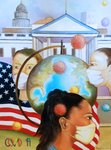
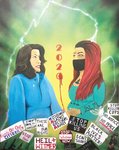

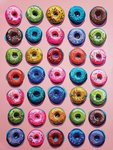
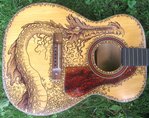
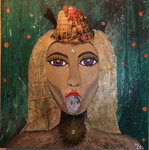
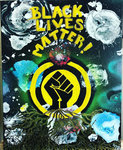
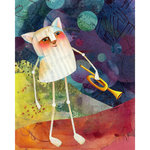
While shutdown galleries lead to postponed exhibitions and canceled festivals eliminate physical marketplaces, Greater Lansing artists are forced to either find a way to pivot their craft to a digital realm or put everything on pause altogether.
Julian Van Dyke has resorted to creating a project unlike anything he has ever done before. Always keeping busy, Van Dyke, who had an April show in New York City canceled, has quietly spent the past few months developing a YouTube show with his son, Paul, that will bring his series of children’s books to life with puppets — not too far off from the format of shows like the timelessly charming “Mister Rogers’ Neighborhood.” Right now, Van Dyke’s living room is taken over by the set of this future online show. The first of his books scheduled for the program to feature is the educational “Does This Make You a Bully?”
“I decided, ‘Let’s just start writing a script.’ I went and bought all of the studio lights and clip-on microphones,” Van Dyke said. “First, we started recording in the garage — not getting the right lighting and picking up too much noise — so we pushed the puppet front into my living room and pushed all the furniture to the side.”
The gamut of new technology Van Dyke has learned while isolated at home is a recurring theme for many artists who have turned to the Internet to show off their work.
“I think corona pushed us in a new direction in terms of showing off one’s work. As you know, whether it’s musicians, entertainers or late-night hosts, they’re all working with the same format. They’re recording from their living room. The playing field has been evened out,” Van Dyke said. “You’re on the same playing ground as galleries. The coronavirus pushed everyone in a new direction; this is the best time to be pushing up your content to be released.”
To make use of other clever alternatives to regular gallery shows, Van Dyke was also the subject of window displays at area libraries back in June. The downtown library branch used its front window space to show an array of original images from Van Dyke’s children’s book “Juneteenth: Celebrating Freedom.” Passersby were able to check out Van Dyke’s work without going inside the actual library.
As a whole, Van Dyke has managed to stay optimistic and keep his sense of inspiration afloat. “I tell people, a true artist will never get bored. I’m not bored. We can’t do anything. MSU’s not playing football, so how are we going to do anything, as far as entertaining audiences? If there’s nothing figured out as far as getting something done about COVID, we’ll just have to wait. I hope it’s soon.”
Dennis Preston has also been frustrated with trying to shift his artwork to being palatable virtually.
“Part of the work I do is drawing caricatures at events. People hire me per hour to draw them and the caricatures are free to those attending,” Preston said. “They started canceling on me in March.There isn’t a way around it, and I’m not going on Zoom to draw caricatures at a virtual party.”
Preston also works heavily on freelance design and illustration. If the piece commissioned was tied into an event or a business that had to be canceled or closed because of the coronavirus, that gig essentially disappeared. The projects Preston has been able to actually complete and get paid for are drawing on music instruments for Vintage Sound in Williamston, producing artwork for media outlets such as City Pulse and designing CD covers for musicians. He also produces artwork for websites that print knick-knacks such as T-shirts and mugs. “Even though I’m doing this, I really don’t make that much per item being sold, just a small percentage. But I’m making those companies rich. They must like me for how much money I’m bringing in for them,” Preston said.
In terms of getting his work out there, Preston has been primarily relying on his Facebook page. Any old stuff he has in his archives he’s sharing it with people there. Preston said, despite the grim prospects faced by the world right now, he’s still managed to find inspiration. “My brain is always on. I can’t turn it off. During this time, I have not been bored. I’ve been drawing a whole lot,” he said.
Visual artist Steph Joy Hogan has also had to move her work online — a major change as she primarily displayed and sold her artwork through recurring community live events, like Arts Nights Out.
“Since March, I have worked hard to adapt my art business to an e-commerce model,” Hogan said. “I have invested heavily in developing a beautiful website to showcase my artwork and deliver it to a wider audience. Additionally, I’ve sought out tools to streamline and improve my social media presence, develop an email newsletter and I completed an intensive business course geared toward artists.”
Her husband, Daniel Hogan, has suffered a similar impact. He was scheduled to appear at the East Lansing Art Festival, which was canceled this year. Instead, he carried on as a virtual showcase on Facebook.
“Missing out on East Lansing Art Festival was a huge blow,” Daniel Hogan said. “The other twist of the knife was I invested in a new vehicle and professional festival tent for this year, and I have yet to use them for an art festival.”
He has since created an online shop on his personal website, in addition to his Etsy page. He was also able to display some of his framed paintings at Blue Owl Coffee, which he said led to some big sales.
Tamara Brown, who is best known for her murals produced under the name Tea Time Art, had her artistic career shaken up not only by the pandemic but also by pregnancy and the difficulties that often arise in the life of a single parent.
“The coronavirus definitely took a toll. Being high risk, as I was pregnant from March all the way until June, I couldn’t go around people or do anything,” Brown said. “All of my sales had to be done online, which was difficult because I was also going to school full time.”
As newborn children are high risk, Brown had to take extraneous precautions with daycare and babysitting. This caused Brown to have to put all mural work on hold.
“I can’t leave him with just anybody. People that go to work, or are regularly around people, have an increased risk of getting infected. It’s tough. I had people ask me, ‘Can you just do it after he’s born?’ I had to say ‘No,’ because I can’t risk him getting sick,” Brown said.
Online sales have proved to not be as easy as one might think. Brown received fraudulent checks for $5,500 worth of art. “I was so pissed off that I made a piece called ‘Put Your Money Where Your Mouth Is.’ I used parts of that check, which I cut up because it wasn’t real,” Brown said.
Other art Brown has produced as of late has been directly inspired by the political turmoil not only surrounding Gov. Gretchen Whitmer’s policies in response to the coronavirus but to the massive wave of protests in response to the police murder of George Floyd. Brown is an avid supporter of the Black Lives Matter movement, as reflected in one of her prints, which prominently features the black power fist as the centerpiece of the painting.
Mina Greco Hall, an Italian-born Lansing artist who emigrated to the United States in the early-’60s and has since earned renown both locally and internationally, has described the side effects of the pandemic as being akin to “prison.” She is unable to teach her usual in-person art classes and hasn’t opted to take any digital alternatives, saying the virtual disconnect of teaching through computer communication would simply not suffice. The disturbing impact of the coronavirus is reflected in Greco-Hall’s painting labeled “COVID-19.”
Svitlana Martynjuk said the pandemic, in a roundabout way, has inspired her to take more initiative with her creative freedom, and not abide strictly to her usual pattern of abstract artwork. For example, one of her favorite pieces she’s produced lately is a wall of delectable doughnuts, an image she said she would have never produced under normal circumstances.
“It’s weird to say, but the quarantine forced me to create art that I actually like. There was nothing else to make,” Martynjuk said. “There were no deadlines; there was nothing stopping me from making stuff that I love. Before I was being driven by customers’ opinions. For the first time ever, I painted representational art instead of abstract. For me, that was a huge deal.”
Without the external pressure of making sales, Martynjuk said a lot of her insecurities faded away. “I felt freer in my painting practice. That was really good,” she said. “I’m taking a different direction; doing whatever I feel like doing. My next collection will be tropical paintings — something I wouldn’t have done before.”
While the world’s response to the coronavirus is in flux, it’s hard to pin down exactly what the “new normal” will be for the art world. The only thing that’s clear is that artists will have to constantly adapt and evolve, or simply wind up left behind.
“I don’t know what to expect for the art world,” Preston said. “Nobody knew last summer that this one would be like this. I don’t use the term ‘new normal’ because this isn’t normal. When you look at what’s going on with our country right now, it’s easy to lose hope and get depressed. But, I’m not there. I’m looking past all of that.”
Support City Pulse - Donate Today!
Other items that may interest you

Comments
No comments on this item Please log in to comment by clicking here